J.D. Porter's Blog, page 7
June 1, 2021
The Dogs of War
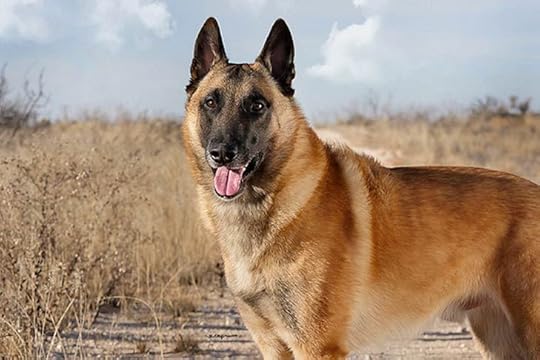 the Belgian Malinois
the Belgian Malinois
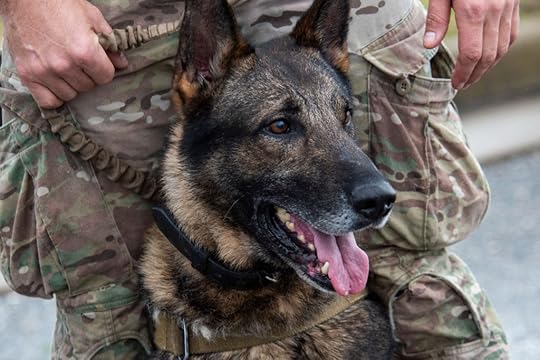
When it comes to books, movies, and TV shows, I am drawn to action and adventure. So when CBS came out with the new war-drama SEAL Team a few years ago, I watched the first few episodes and was hooked. I liked how the Navy SEALs were inserted into a hot zone by helicopter, watercraft, or parachute and how they entered a building in close formation in a carefully choreographed series of moves. But it wasn’t the big burly men dressed in camo, wearing night vision goggles, and carrying H&K 416 carbines that drew me in. I was attracted to one particular member of the team—a member whose gear was specially made to fit his unique form and who was often the first one into danger. He was a Belgian Malinois named Cerberus—a war dog.
We humans have been using dogs in battle for centuries. The ancient Greeks and Romans took dogs into battle. The Spanish conquistadors used mastiffs and other large breeds to intimidate native peoples during their exploration of the Americas. And in World War I, the Germans used herding dogs they called Alsatians as sentries, messengers, and ammunition carriers. The most famous of these early war dogs, and one I grew up watching on TV, was Rin Tin Tin.
The real Rin Tin Tin was a German shepherd that was rescued from a World War I battlefield by an American soldier and trained for work in silent films. His legacy continued into the 1950s with a television series, The Adventures of Rin Tin Tin. The magic of television transposed his “war dog” exploits back to the American West of the 1800s.
In WWII, the Marines adopted the Doberman pinscher to help them take back the Pacific Islands from the Japanese. My generation served in the jungles of Vietnam, where thousands of dogs—mostly German shepherds—served alongside our troops. Their handlers affectionately called them “fur missiles”.
Today, a new breed of canine soldier has emerged, the Belgian Malinois. This is another herding dog similar to, but smaller than, the German shepherd. Malinois, like German shepherds, have long worked with police departments. In fact, the American Kennel Club noted in the 1908 issue of their newsletter, that five “Belgian Sheepdogs” had been added to the New York City police department.
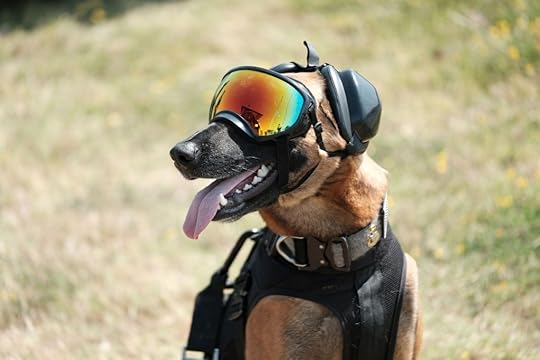
The Belgian Malinois (or Mal) is one of the top breeds chosen by police departments around the country and they are important members of the U.S. military—where they are officially known as Military Working Dogs. Most of the dogs that work with the elite Navy SEALs are Mals. SEAL dogs, like the TV star Cerberus, are given their own special body armor and are even fitted with night-vision goggles. One of the reasons Belgian Malinois are favored over German shepherds for many military operations is that Mals are lighter, so it’s easier for military parachutists to do tandem jumps with their dogs strapped to them. Mals can even be trained to jump on their own, which is reportedly safer for the dogs when they land in water.
I know TV does not represent reality. If a building blows up around you, you probably won’t survive. The results of DNA tests don’t come back in minutes. And people don’t always live happily ever after. But I grew up watching television working dogs like Lassie and Rin Tin Tin perform amazing and dangerous tasks to help their human partners. So the use of dogs in wartime, seems no worse to me than sending troops—especially those that did not volunteer—into battle. The dogs just need to be treated as valued partners not expendable objects.
The TV SEAL team dog, Cerberus, is portrayed as an equal member of the team. In one episode, he begins to lose his edge and runs away in a firefight. He appears to be lost. But in a subsequent battle we see shades of Lassie and Rin Tin Tin when he saves one of the SEAL team members. The man discovers that Cerberus has a deep knife wound, so he bandages the dog, puts him on his back, and carries him to safety. Cerberus retires with PTSD and goes home to live with the SEAL team member he saved. I like to think that this Hollywood ending is one that would also play-out in real life.
I have always had a special admiration for warfighters—and not because I live in a Marine Corps town. When I was in my early teens, my older cousin Roger enlisted in the Marines. When he came home from boot camp, I was in awe of him. He was the biggest, baddest dude I had ever seen. Interestingly, he was stationed in Albany at some point in his career. Soon after I moved to Albany, I heard from his brother Johnny, who was in the Air Force, that he and Roger were both stationed in Albany, Georgia at the same time in the 1970s—Johnny at Turner AFB and Roger at MCLB.
Sadly, although my cousin Roger survived several tours in Vietnam, he later succumbed to the devastating effects of the war’s PTSD. Roger is still one of my boyhood heroes—one of thousands of war fighters who have sacrificed so we might live free. I wonder if he ever went into battle with one of those “fur missiles” as part of his combat team. In my imagination, he might have led his squad into a jungle firefight following a German shepherd and his handler.

When I first watched SEAL Team, I was surprised to see Cerberus jump out of an airplane. I didn’t know whether to feel sorry for him or marvel at his bravery. But as I observed the dynamics of the dog’s relationship to the team, I came to understand that, TV dramatization notwithstanding, he was part of the team. He was doing what dogs are bred to do. He was carefully trained, lovingly accepted, and prepared to do his part for the “family”. Some dogs are bred and trained to hunt birds, some to sniff out contraband, and others to herd sheep. Dogs like Cerberus are warfighters, and we owe the real warfighters—both human and canine—a debt of gratitude for their service and their sacrifice, especially on this Memorial Day.
May 12, 2021
A Murder of Crows
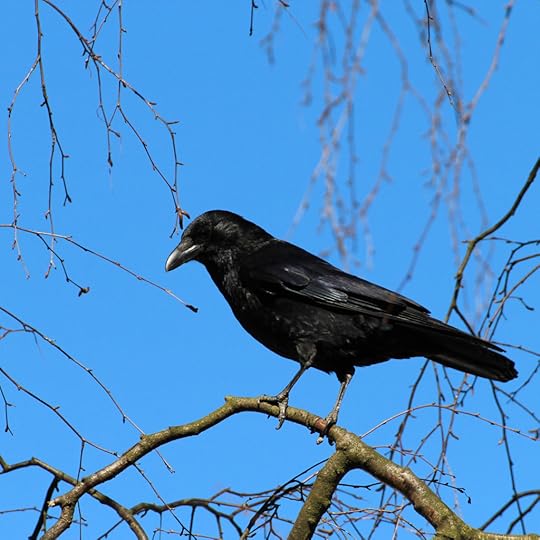
What is the smartest animal—after humans and primates? Some think it is the animal strutting around my backyard as I write this. I often see him from my upstairs office window, walking in a wide, apparently aimless circle occasionally stopping to pick at something on the ground. He crosses the patio, walks through the gravel, and back onto the lawn before hopping onto the edge of the birdbath. After a quick drink and another look around, he flies off. He is one of the American crows that comes back to my yard and frequents the birdbath every year in the spring. He is probably nesting somewhere in the area.
When it comes to smarts, that crow is not just another birdbrain. When we think of animals using tools, for example, we often think of primates. But one species of crow that is native to the South Pacific island of New Caledonia has been called a “flying primate” because of its tool making ability. New Caledonian crows have been observed bending twigs into the shape of a hook to fish bugs out of rotting logs. Researchers suggest that these crows might be the only other animal besides early humans that habitually make hooks in the wild. Other tool-using crows have been seen carrying cups of water to bowls of dry food and breaking off pieces of pinecone to drop on tree climbers near a nest.
And how many animals do you know that hold funerals for their dead? Researchers have observed groups of crows surrounding a recently deceased bird. But the funeral isn’t to mourn the dead. The crows are thought to gather together to find out what killed their member.
According to the Cornell University Ornithology Lab, American crows (Corvus brachyrhynchos) are common all-over North America ranging from open woods and empty beaches to town centers. They are significantly larger than other black birds and much smaller than ravens, which are found from the Northern United States to the Canadian arctic. Their flight style is described as a patient, methodical flapping that is rarely broken up with glides, and their loud caw is unmistakable. Though crows tend to be solitary, they often forage in groups and some crows, especially the yearlings and non-mating adults, live in roosting communities. A group of crows is called a murder. A murder of crows will sometimes band together and chase predators in a behavior called mobbing.

Crows usually feed on the ground and eat almost anything, including earthworms, insects, small animals, seeds, and fruit. They will also pick through garbage and stop on roadways to feed on roadkill. But Crows are not just scavengers. They are crafty foragers that sometimes follow other birds to find where their nests are hidden so they can eat the chicks. They also been observed stealing food from other animals and eating from outdoor dog dishes.
When I see the crows in my neighborhood, I can’t tell one from another. They are jet-black and have no distinguishing characteristics. But crows, according to a story on National Public Radio, can recognize and remember me. Wildlife biologists figured this out by conducting experiments using rubber masks. They dressed humans in two masks, one designated a “dangerous” face and another mask as the “neutral” face. Researchers in the dangerous mask trapped and banded individual American crows and then released them. While they were careful not to harm the birds during trapping, it was still a frightening experience for the bird.
To see whether the crows remembered the dangerous face, researchers returned to the area and walked around wearing the different masks. When the birds saw the dangerous face, they gave an alarm-call and dive-bombed that person. They mostly ignored the neutral face. Researchers even wore the mask upside down to see if the crows could still recognize it. For a brief moment, the crows seemed confused, but when they turned their heads upside down, they sounded an alarm-call.
Even crows that had not been tagged or banded scolded and dive-bombed the wearer of the dangerous mask, suggesting the crows were learning from their peers that this particular person is dangerous. And, if you need another reason to be nice to crows, researchers suggest that they can remember faces for years.

That crow splashing around while he takes a bath in my back yard is so large, he fills the birdbath and splashes most of the water out of the bowl. When he takes off in the late afternoon sun, the water glistens on his black feathers and it sprays off of his flapping wings until he lands in a nearby tree. As I walk out with the garden hose and refill the birdbath with fresh water, I wonder if he is sizing me up and memorizing my appearance. I gaze up at the crow and give him a good look at my face. It can’t hurt to be on the good side of an animal whose group is called a murder and who is known to mob his enemies. Besides, since there are no primates around, he is probably the second smartest animal in the neighborhood—which probably isn’t saying much.
April 16, 2021
Therapy Dogs
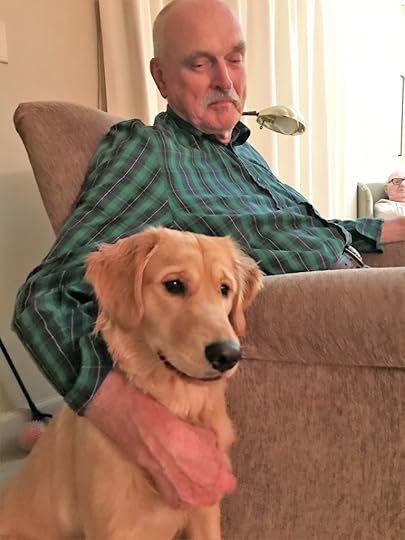 Libby
LibbyAll it takes is a touch. I can feel it when I place my hand on Libby, my son’s golden retriever. It is a sense of calm and wellbeing that defies rational explanation. I can’t say why I feel it or from whence it comes. It is as though I am in therapy. But make no mistake. Libby is no therapy dog. She is a rambunctious one-year-old that still chases her tail on occasion. The real therapy dogs are in courtrooms comforting distraught, abused children or in rehab centers helping patients in their healing process. They are dogs like Rikki, a small, reddish-colored golden retriever.
I met Rikki about a decade ago at the rehabilitation clinic of the Tallahassee Memorial Hospital (TMH). I was visiting my mother after her knee replacement and Rikki was making her rounds, meeting patients and bringing encouragement to people who were struggling to get their lives back. Rikki’s story has been told by Julie Strauss Bettinger in her 2016 book, Encounters with Rikki.
Rikki, it was said, could read a person’s body language from a young age. She engaged visually with people by making eye contact, and she would bow her head and tentatively reach out to certain people. She even offered herself to a woman with Parkinson’s disease in spite of the woman’s uncontrollable tremors. By nine months of age, she and her owner, Chuck Mitchell, were enrolled in an animal therapy training program.

Training a therapy dog involves teaching the dog and handler to interact safely and reliably with the elderly, with young children and with the physically impaired. Dogs learn not to be afraid of elevators, medical equipment, and noisy environments. Trained therapy dogs and their owners volunteer in settings such as schools, hospitals, and nursing homes. One of Rikki’s first assignments was as a courthouse therapy dog where she worked with a six-year-old girl who had been sexually abused. Since abused children must tell their painful stories in a courtroom in order for the abuser to be convicted, the frightened little girl learned she could tell her story to the dog—a non-threatening listener she had come to trust.
Therapy dogs are distinct from service dogs. Service dogs are trained to perform specific tasks to help a person with a disability. A service dog might guide an owner who is blind or assist someone who has physical limitations. And while Therapy dogs are there to be touched and petted, service dogs are not. Service dogs should not be approached without the owner’s permission.
Service dogs must remain with their person at all times and are the only animals that have special access privileges in public places such as on airplanes and in restaurants. Therapy dogs, even the dogs who have earned the American Kennel Club Therapy Dog title, do not have that same special access, nor do the third classification of support dogs—those that offer emotional support to their owners.
Although all dogs have an emotional connection with their owner, the AKC suggests that to legally be considered an emotional support dog, the pet (which apparently can be almost any type of animal) needs to be prescribed by a licensed mental health professional to a person with a disabling mental illness. I am a dog-person myself, but emotional support animals come in all shapes and sizes. Cats and horses are probably a close second to dogs and I have been known to hug my mules when I am brushing them down before a day of pulling the wagon. My sister-in-law, Sheree Porter, manages the rehab program at TMH. She was a pioneer in their use of therapy dogs like Rikki and she has gone on to harness the therapeutic powers of birds, horses, and a donkey named Daisey Mae.
But, the days of bringing your emotional support animal on an airplane came to an end in December of 2020 when the federal government enacted a new rule restricting the types of service animals allowed on commercial airline flights. Now, airlines only allow dogs that meet specific training criteria. The new Department of Transportation rule, according to a report on National Public Radio, was in response to a growing backlash in recent years to airline passengers trying to bring all kinds of wild and outlandish animals onto airplanes, including the woman who tried to bring an “emotional support” peacock on board a United Airlines flight in 2018, and the “comfort” turkey that was actually allowed to fly on Delta Airlines back in 2016.
Studies show that interaction with a dog can lower a person’s heart rate and cause blood pressure to go down. Petting Libby, I have come to learn, stimulates my production of oxytocin—a hormone that is associated with empathy, trust, and relationship-building. It also releases endorphins which are chemicals produced by the body to relieve stress and pain.
The nature of the dog-human bond is exceptional. It is similar to the classic “pair bond” which is usually between two mated individuals—like my wife and me. She and I enjoy hanging out together. We obey each other (for the most part), we care for each other when necessary. and we greet each other enthusiastically when we reunite. Touch is how we like to connect. We share an innate drive for contact, with a bond that both pleasurable and hormonal. I hope my wife doesn’t find out that all of this could also describe my relationship with my dog.
March 26, 2021
The Dog’s Nose Knows
Dogs “see” the world through their noses. My first direct experience with this almost mystical ability came early in my zoo career. Those were the days when my wife insisted that I disrobe in the laundry room and jump in the shower when I got home from work. It was not because of some unknown contagion, as with today’s medical professionals. It was because—not to put too fine a point on it—I often stank.
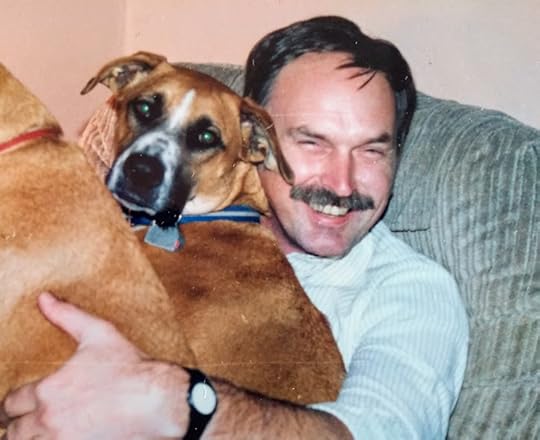 Simba, the guard dog
Simba, the guard dogOne evening when I was leaning against the washing machine, exhausted from a day of manhandling a herd of antelope for a medical procedure, my dog Simba—a big brown rescue-dog of unknown lineage—wandered in wagging her stump of a tail. She licked me on the hand, sniffed my leg, and snarled at my pants as she jumped back barking. Simba was warning me of unseen danger in our midst.
For humans, smell is often considered our least important sense. I didn’t smell anything on this particular evening, but Simba sure did. After nearly half a century of working with animals in zoos, I have become desensitized to smells. During my career, I have shoveled wheelbarrows full of elephant poop, hosed urine-soaked tiger cages, and had angry chimpanzees splatter me with their feces. After a while, I just learned to turn off my smeller. My wife also overcame her aversion to animal aromas. She helped foster a baby gorilla when I was deputy director of the Toledo Zoo and thirty years later, she still remembers the strong, earthy, old-fruit smell of the gorillas.
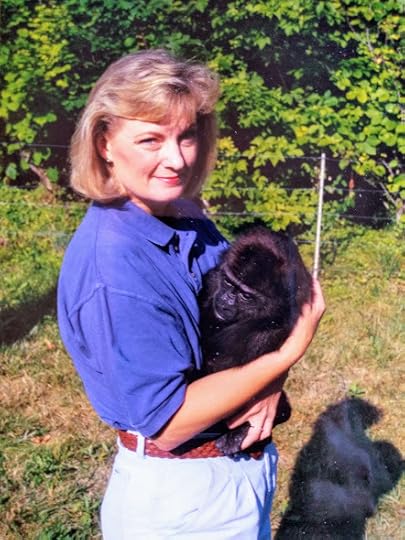 Karen and baby gorilla, August 1999
Karen and baby gorilla, August 1999It was, I suppose, not that difficult for me to block certain smells since the human sense of smell is somewhat rudimentary. The inside of our nose is lined with specialized tissue which can receive air-born molecules that our brains process as scents. The tissue inside a human nose is covered with five or six million receptor sites, all clustered in one spot at the back of our nasal cavity. That might sound impressive until we consider that a dog’s nose has forty times as many receptors—two or three-hundred million. They line the entire internal surface of the dog’s nose from the nostrils to the back of the throat. In addition, the dog’s brain devotes much more capacity to processing those smells. The smell experience for a dog is exponentially more acute than ours. Simba had never seen an antelope, but she knew that whatever she smelled on my pants did not belong in her house.
We humans have recognized the power of a dog’s nose for millennia. A third-century scholar, for example, mentions “a hound of unrivaled scenting powers, so intensely devoted to his work that he could not be pulled off the trail until his quarry was found.” Perhaps this was an early version of the modern bloodhound.
According to the American Kennel Club, bloodhounds as we know them were perfected in Western Europe about a thousand years ago. During the centuries since, they have earned a reputation as trackers without equal. Police departments around the world have relied on bloodhounds to follow the scent of criminals, lost children, and confused seniors. But we have come to learn that the dog’s ability to identify a scent may be less about the breed and more about desire and training. Dogs can not only sniff out a quail in deep grass or follow the days old trail of an escaped outlaw. Dogs can also be trained to detect drugs, explosives, and even cancer. What if they could detect the coronavirus? Well, perhaps they can.
According to recent news reports, dogs have, in fact, been trained to detect COVID-19 by sniffing human sweat. European airports have been using dogs for months and, in January, Florida International University announced it would be using dogs to scan classrooms and labs for traces of coronavirus. That same month, the Miami Heat basketball team had COVID-19 detection dogs sniffing its fans as they entered the arena for a game.
Science tells us that a scent is a chemical particle that floats in through the nose and is processed into a form that’s readable by the brain. Brain cells then carry that information to the amygdala—the same area of the brain that processes emotions—before taking it to the adjoining hippocampus, where learning and memory formation take place.
Scents are the only sensations that travel a direct path to the emotional and memory centers of the brain. That results in an intimate connection between emotions, memories and scents. Perhaps that is why we can use specific scents to sell. Realtors have suggested sellers bake cookies just before a home showing. Bakeries have been known to exhaust the smell of cinnamon buns baking in the oven to entice customers into the store. And this is why memories triggered by scents (as opposed to other senses) are experienced as more emotional and more evocative. A familiar but long-forgotten scent can even bring people to tears.
When I worked with elephants, I discovered a scent so strong that I brought it home infused into my clothing and hair. Even a long, hot shower sometimes failed to rinse it off. Elephant smell was best described by John M. Kelley, of the Ringling Bros. and Barnum & Bailey Circus when he said:
“You cannot see it or feel it, yet it clings like a mother’s love. Its vaporized essence is so real that you cannot dilute it, dissolve it, liquify it, freeze it, smother it, counterfeit it, cut it, shake it, or lose it. Elephant smell is the fourth dimension.”
When I am driving the mule wagon on a quail hunt, my passengers spend the day watching dogs use their sensitive noses to sniff out tiny birds in acres of deep grass. In contrast, when the mules a few feet in front of us defecate, the pungent earthy smell barely registers with we humans. It is the sight of what they are doing, not the smell, that causes us to recoil. But let an over-excited hunting dog poop in the wagon box behind us and our threshold for smelling kicks into high gear. That’s a “vaporized essence” that triggers some evocative emotions—emotions that have all of us on the wagon ready to abandon ship.
March 8, 2021
A Home for the Gnomes
Anyone who knows me, knows I like to write. There is just something about the creative process that I find satisfying—finding the right word, the perfect turn of phrase, the rhythm of the story. During last year’s COVID isolation I finished writing a memoir and a novel—my third and fourth books—but that 74,000-word novel did me in. It was like running a marathon. I’m glad I did it, but I don’t plan to do it again. I need to find a new creative outlet.
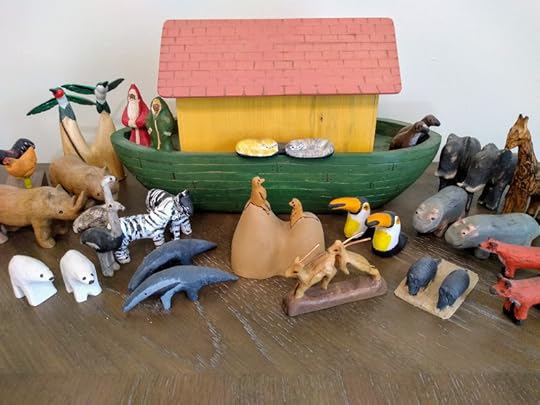 Noah’s Ark
Noah’s ArkThirty years ago, I fancied myself a woodcarver. I liked to create animals and accumulated quite a collection of wooden birds, mammals, and reptiles. In the early 1990s, I made a small Noah’s Ark for my wife as a Christmas present. My plan was to give her two, tiny new animals every year thereafter. I enlisted our three-year-old son Ian and we carved and painted the animals together. We amassed a collection many zoos would be proud of, from zebras to hummingbirds and elephants to meerkats. We finally stopped the two-decade-old tradition when he was grown. In fact, I stopped carving altogether. I had run out of room to store all of my carvings and ran out of friends and relatives to fob them off on. That’s when I turned to writing.
 Artist at work
Artist at workCreativity can take many forms, as we observed during last year’s pandemic shutdown. My wife is an accomplished painter. She spent some of her time in lockdown making art. Musicians who couldn’t play their instruments in a concert hall, played for their neighbors from the balcony. Baking supplies were scarce because folks were making cakes. Australians amused themselves by dressing up in costumes for their only outing of the week, taking out the garbage (or, as they call it, the wheelie bin).
One of the things that struck me during the pandemic creativity-binge was how much of our creativity is drawn out by bringing joy to others. Creativity comes from a combination of talent and enjoyment of the process, and it thrives in the presence of an appreciative audience. I enjoy writing these articles, but I also like it when people stop me in the grocery store to tell me how much they like reading them. Those cooped-up musicians in Italy who were playing Bach from their balconies probably listened carefully for the smattering of applause from the high-rise canyon of apartments around them.
Many of us have creative energy we scarcely recognize. We make creative COVID masks, we photograph, we bake, we write, we start a home-grown business, we even dress up like a dinosaur to take out the trash. It is part of the human spirit. And if you don’t know how to do something, you can take some lessons or you can YouTube it. That’s how I learned how to repair my lawnmower, refinish my wooden staircase, and change the cabin air filter in my 2011 Nissan Rogue. Creativity takes many forms especially if you can’t afford to pay someone else to do it.
Creativity is good for the soul and it runs in my family. My dad was a plasterer by trade but always worked with his hands. He grew plants, created a back yard smokehouse, designed a rockscape waterfall, worked on cars, and built a garage addition on our house. My own creativity runs in so many directions that I sometimes experience a kind of creative ADHD.
I created built-in bookshelves in my last three homes and a fireplace mantle in our current home. My wife and I constructed a shed, a fire pit, and dug a goldfish pond with a fountain. When hurricane Michael destroyed our swimming pool, we filled it in and turned the space into a formal garden—complete with handmade steppingstones and a giant urn bubbler. In the last couple of months I made a new furniture cabinet for the back porch and a set of giant Jenga blocks for my grandchildren.
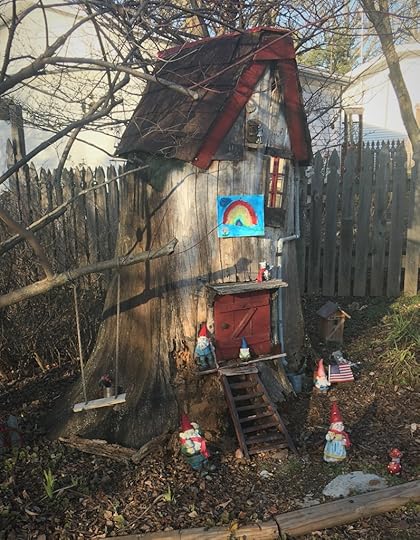 The Gnome-stead
The Gnome-steadLong before the pandemic, my father-in-law’s neighbors in Louisville, Kentucky let loose their creativity by turning an old tree stump at the edge of their yard into a Gnome Home. It was complete with a roof, doors, windows, and several gnomes doing chores around the gnome-stead. And the scene changes with the seasons and holidays. People are constantly stopping to admire the gnomes and take their pictures. I am sure that was the goal of the Powells when they created this inspired diorama.
Now that my father-in-law has passed away, my wife is repaying the help and kindness the Powells provided him by doing a painting of that gnome home for them. Her creativity has been unleashed by theirs and will likely bring them joy for years to come.
In the 1980s, early in my wood-carving years, I answered an ad in the newspaper from someone selling some woodworking tools. I was in the market for some chisels. When I arrived at the home of the seller, I was met by a woman who turned out to be the widow of a woodcarver who had recently passed away. She escorted me to his workshop where I picked out a few chisels from his collection. But as I self-consciously sorted through a dead man’s tool collection, I came face to face with an uncomfortable reality. Perched on the man’s work bench was a life-sized wood carving of a great blue heron. It was unfinished and still emerging from a block of wood, but it had a well-defined beak, head, and neck. It was beautifully done, and I found it at once humbling in its quality and inspirational in its beauty. Now, as I look back on that experience from nearly four decades, I see another message. That man was working on that bird right up until the end. His unfinished work left a piece of him behind for us to admire—a kind of unintended legacy in wood, still bringing joy to others. That is what creativity is all about.
That is what I hope for myself. I want to leave an unfinished work, whether it be a carving, a piece of furniture, or one of these articles. I want to bring pleasure to others by creating right up until the end. I do have an idea for another book. Or maybe I’ll dust off my chisels and make another pair of animals for the ark. But no, I need a new challenge—something I’ve never tried before. Maybe I’ll make a home for the gnomes that live in my garden. There are seven of the white-bearded little guys. I talk to them sometimes, one old man to another. Surely I didn’t imagine their faint voices early in the morning singing, Heigh-Ho, Heigh-Ho, it’s off to work we go. Or maybe that final project is nearer than I thought.
February 22, 2021
Greyhound Rescue
Second Chance Greyhounds out of Douglasville, Georgia describes itself as a dedicated group of volunteers working to place former racing greyhounds into adoptive homes. But Second Chance is unique. Their dogs are fostered and trained by inmates in the Georgia prison system. One of the programs is at the Jenkins County Correctional Facility in Millen, Georgia—a program that provides an opportunity for inmates to give back to the community while alleviating boredom and tension in prison, resulting in a safer environment for both staff and inmates.

The goal of any training and socialization program is to increase retention of greyhounds in their new adoptive homes. Second Chance offers the added benefit of allowing prison residents to experience first-hand, the unconditional love of a pet—a novel experience to many inmates. One fascinating aspect of the program is the blog that provides an inmate report on the dog’s progress. Diggory’s inmate mentor named the dog Hector and here is a selection of his reports on Hector (Diggory).
3/8/2020 – Hi there from Hector the Handsome Hound! Hector’s trainer loves this guy already. He is so intelligent, loving and gentle.
3/29 – This week has been a great week for this sweet pooch. Hector is enjoying his time at Second Chance Greyhounds Academy. He loves being able to roam around freely and play with his toys, but nothing compares to the love he has for his bed. Relaxing during retirement couldn’t be sweeter for Hector.
5/10 – Well, we’ve reached the end of the 10-week training program. Hector’s inmate trainer says that he’s truly enjoyed working with this smart boy. You can’t help but smile when you’re around Hector! His inmate trainer says that he believes Hector is going to make a great addition to his new forever family.
Greyhounds are trained athletes that are bred for speed, endurance and an even temperament. They are handled a great deal during their early years by dog walkers, trainers, veterinarians and others, so they love being around people. But, since they are raised in a monoculture of other greyhounds, they may be uncomfortable around cats and other breeds of dog—especially small dogs that might resemble the fluffy, white rabbits they were trained to chase at the track. Part of the adoption profile is a statement of their tolerance of cats and small dogs. According to his profile, Diggory was not tolerant of either. In real life, however, he learned to get along with my son’s rambunctious golden retriever, Libby, and seemed to relish the company of a quiet, seven-year-old cocker named Alice.
The literature describes greyhounds as possessing superior intelligence while exhibiting a quiet but surprising independence. I observed those qualities when Diggory first walked into the room and surveyed all who were present. His independence was evident in the story his owner told of the time Diggory caught a bird in flight. Before Will could react, Diggory had eaten the bird in three gulps—feathers and all. It reminded me of our young, quail hunting cockers that must be trained to give up their birds. They, too, would eat the birds given enough time.
I feel a sense of kinship with greyhounds. We are both tall and lanky while exhibiting a quiet but surprising independence. But we do differ in at least a couple of ways. I have never been that guy who could walk in and take over a room full of strangers. In fact, I hate walking into a room full of strangers. And as to possessing superior intelligence, well nobody has ever accused me of that, either.
February 15, 2021
Racing Dogs
My connection with greyhound racing is etched in vivid childhood memories. My dad was a plasterer who had a second job to help support our family. On weekends and Wednesday evenings he worked as an assistant starter at Derby Lane dog track in St. Petersburg, Florida, helping place dogs in the starting box before each race.
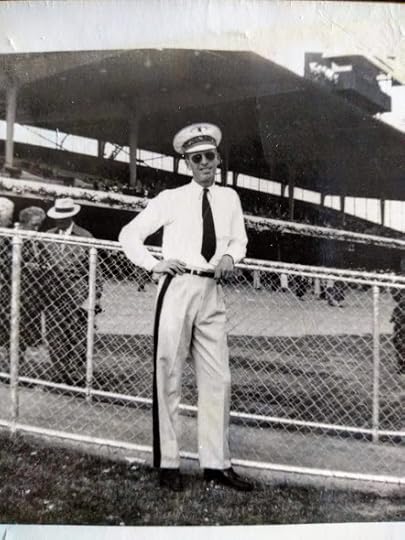 Jim Porter at Derby Lane
Jim Porter at Derby LaneDerby Lane, the St. Petersburg Kennel Club, claims to be the oldest continuously operating greyhound track in the world. It was carved out of palmetto scrubland on the edge of Tampa Bay in the 1920s. The club’s first race was held on the afternoon of January 3, 1925. The final race was nearly a century later in December 2020, just days before greyhound racing was banned in Florida. According to the Humane Society of the United States, greyhound racing is cruel and inhumane and is now illegal in more than forty states, including Florida.
I wasn’t allowed to attend the regular dog races because Derby Lane was a gambling establishment—no children allowed—but I did go to the schooling races on occasion. These were practice races, probably for young dogs, and I never observed anything cruel or inhumane.
The starting box, where my dad worked, consisted of a long, low unit with eight greyhound sized stalls. The handlers walked the dogs to the box on a leash and my dad helped them remove the leash and stuff dogs in the box. Each dog wore a colorful vest with a number from one to eight on it. Once the dogs were loaded, a mechanical arm was activated and a fuzzy, white artificial rabbit began its run around the track. My recollection is that the starter held a button in his hand that was connected to the dog box by a cord. When the mechanical rabbit was in front of the box at a spot the starter was looking for, he pushed the button which caused the entire front of the box to burst up and expose all of the dogs to the rabbit at the same time. When they bolted out in their colorful vests with their front legs extended and their necks stretched out toward their quarry, it was the most exciting thing I had ever seen. They raced around the track chasing the rabbit which glided along its arm on the inside rail.
I assume that somewhere, someone was controlling the speed of that mechanical rabbit so the dogs were close behind, but they could never quite catch it. After they had crossed the finish line, the rabbit snapped into a box along the rail and the dogs gathered at the box where they could be retrieved by their handlers. The dogs were excited and winded after the chase, but they appeared happy to me as a young boy as they danced around with their tails wagging. Of course, I only saw the end result. I could not know how these majestic dogs came to be there.
According to the ASPCA, racing greyhounds routinely experience terrible injuries during training and when racing. And, while greyhounds may live a dozen or more years, they were usually retired from racing by two to five years of age because they were either deemed unfit to race after an injury or no longer fast enough to be profitable. Today, most of these retired dogs are sent to rescue groups. In the sordid past of this cruel sport, they were quietly euthanized. Today, there are hundreds of rescue organizations around the country that are ready to step in on their behalf—organizations like Second Chance Greyhounds out of Douglasville, Georgia.
February 8, 2021
Diggory the Dog
Have you ever been at some event or gathering when someone walked in and took over the room? Perhaps it was the host, or the guest of honor, or maybe a well-known celebrity. But the moment they walk in, the electricity changes. Conversations slow, eyes turn, the air seems to get sucked out of the room. I have seen it with people on numerous occasions, but the day I met Diggory was the first time with a dog.
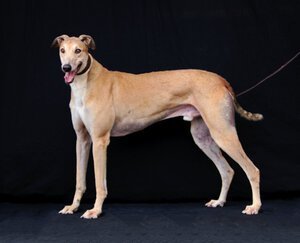
He came into my son’s living room from the basement apartment where he lives with his owner, Will. His arrival was unexpected. The door to the basement opened and there he was, striding confidently—majestic and regal—into the room. Diggory is a fawn colored, seventy-five pound, three-foot-tall greyhound. I was nearest the door sitting at the kitchen table, so he came to me first, gazed at me across the table, sniffed my arm, and moved on. He checked both humans and dogs as he circled the room, moving with the easy, fluid grace of an elite athlete. He finally curled up on an impossibly small dog bed in the corner.
From the moment I saw Diggory, I could see why greyhounds are such special creatures. Diggory is the essence of the dog breeder’s credo form follows function. From his sleek, aerodynamic head to his broad chest that curves into a tightly tucked waist, his smooth hide is stretched over muscle and bone without an ounce of fat.
Greyhounds have been an object of fascination for artists, poets, and kings for as long as human beings have been civilized. Legend has it that Cleopatra had coursing greyhounds and they were the hunting hounds of ancient mythical gods and goddesses. Over the centuries, greyhounds have traveled with explorers and generals, adorned the suites of kings and queens, and appeared in fine art and literature.
According to the American Kennel Club (AKC), greyhounds belong in the Hound Group—a diverse lot that defies generalization. Hounds can be long, low dachshunds or Irish wolfhounds, the AKC’s tallest breed. The group includes elkhounds, coonhounds, deerhounds, Afghans, and beagles. Most hounds share the common ancestral trait of being used for hunting. Some use an acute sense of smell to follow a trail. Others demonstrate a phenomenal gift of stamina as they relentlessly run-down quarry. And then there is the blinding speed of the greyhound.
Greyhounds may not be in the AKC sporting dog group but make no mistake, greyhounds were bred for the hunt—primarily for hunting in the open where their pursuit speed and keen eyesight were essential. The original use of greyhounds was in running down smaller animals for meat. In the British Isles and on the Continent of Europe, they were prized for their ability to chase deer for meat and sport. Later, they became specialized in competition hare coursing. Some greyhounds are still used for coursing in artificial lure sports like dog racing. Before he retired, Diggory was a racer. He ran under the name Mega Diggory and some of his races can still be seen on the internet.
Next week, we’ll take a look at the “sport” of dog racing.
January 31, 2021
Hunting Dogs as House Pets
When I began my retirement career as a wagon driver about five years ago, part of the morning routine was driving the wagon to the kennel to load all the dogs—all the dogs, that is, except Joy. Joy did not sleep at the kennel during hunting season. She slept on the seat of the wagon. She was there every morning when I arrived, curled up on the blanket I had prepared the evening before. She refused to be lured into the kennel or the barn on cold nights, so we had to rig up makeshift tents and heat lamps. I’m not sure how or why the practice began, but that’s just the way it was. Joy was about as pure a hunting dog as I ever saw. I don’t believe she would have ever been happy sleeping on someone’s couch. Penny the Labrador retriever, on the other hand, seems to enjoy both worlds. She sleeps in a comfortable house but is a formidable hunting dog.
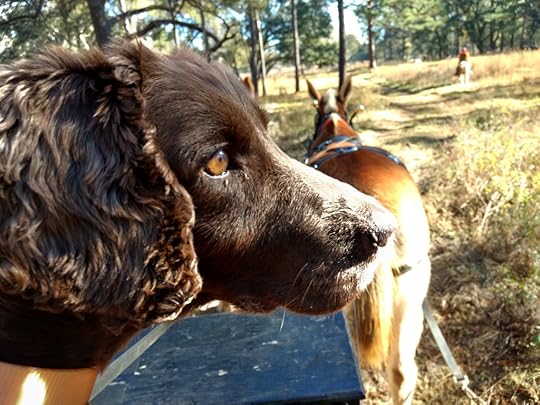 Joy on the Wagon
Joy on the WagonLike most dogs, Penny arrived with her hunting instincts preloaded. At just a couple of months old, she was bounding after and retrieving her stuffed penguin in the house. Soon after, she was introduced to bumpers, which are plastic or rubber dummies that are used to train retrievers. She quickly learned how to “heel”, or stand at the trainer’s hip, and to wait until her name was called to retrieve the bumper. Jared hunts out of a wide kayak known as a “layout boat” so Penny had to learn where to sit and how to jump back in the boat after she retrieves ducks.
A hunting dog has a lot to learn and will thrive on training and practice, so I wonder if there is a trade-off by having a hunting dog live in the house. Jared wonders that, too. Perhaps, he suggests, if he were stricter or “kept it more businesslike”, Penny would be even better in the field. But her being a mix of family dog and gun dog is what he and his wife want. So Penny must make up for her lack of intense training with some instinct and a good bit of skill. And one of the best illustrations of her combination of instinct and skill was illustrated on one recent trip.
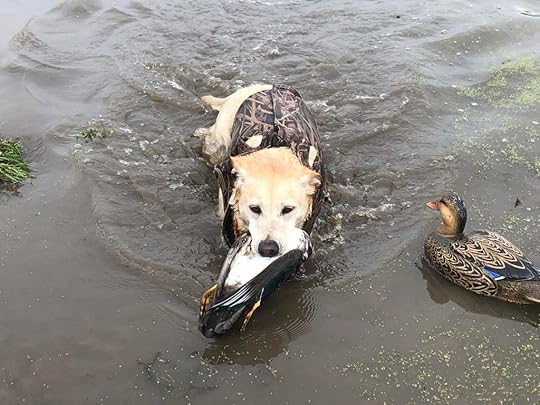 Penny brings the duck
Penny brings the duck“Wood ducks were the main bird we hunted,” Jared recalls, “and we had to work hard to sometimes scratch out one or two. This day ended up being … especially noteworthy because one duck actually dove, and Penny went under as well and came up with it. That’s definitely not a trained skill!”
As a dog owner, it is useful for me to know what makes my dog happy. Dogs like Libby and Penny are retrievers, so they want to, well, retrieve. Penny is an expert at retrieving ducks from water-filled swamps while Libby is constantly trying to sneak sticks into the house after a walk. Cockers like Millie, Shep, and even Alice, will enjoy an opportunity to take their time and have a good sniff around their world.
 Jared and Penny
Jared and PennyAnd which of these hunting dogs have it best? My son’s dogs Libby and Alice, who live a life of ease and comfort; Joy, who slept on a wagon seat and knew nothing but the hunt; or Penny, who appears to have the best of both worlds? There is no right answer to this. Dogs are our original hunting companions—our oldest canine partners. They just want to be with us, doing what we do.
Come to think of it, these hunting dogs are a little bit like me. I love the hunt and am attentive when on the wagon—perhaps because people are waving loaded shotguns in my direction—but I also enjoy stretching out on the couch after the hunt like a spoiled house pet. And, contrary to what my wife says, I require very little training.
January 25, 2021
The Retriever
In quail hunting, “marking” a bird means making careful note of where it fell so it can be retrieved. As the wagon driver on a hunt, I try to mark any birds that fall in my vicinity. Landmarks are scarce in quail country, so I might use a tree, a shrub, or the edge of the road. On one cold January morning we were hunting near a water-filled low area called a “bottom”. When one of the birds fell in the middle of that bottom in a foot or two of water I marked where it splashed down, but assumed it was lost. Nobody was likely to wade out into the freezing water to retrieve that bird.
The hunter and guide gathered at the water’s edge to gaze out to their lost quarry and to my great surprise the guide turned back to the wagon and called for Joy. The excited cocker had been watching intently. She scrambled down off the wagon without hesitation to join the hunters, but she did not stop at the water’s edge. She blew past the men, jumped into the water, and splashed out to where the bird had fallen. A few moments later, she was back on the wagon soaking wet with a quail dangling from her mouth and muddy ice-water dripping all over my seat.
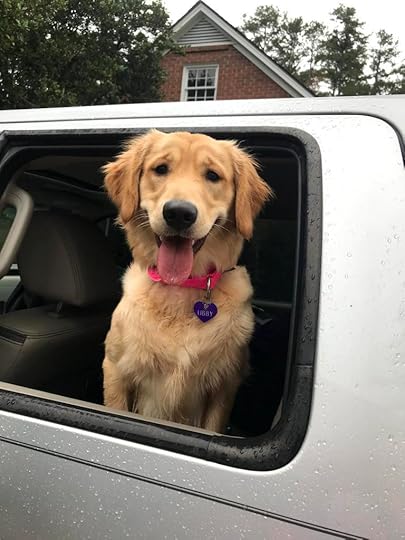 Libby the golden retriever
Libby the golden retrieverOur thirty-pound cocker had no trouble bounding through the water to retrieve a six-ounce quail. But what if we were hunting waterfowl? Joy couldn’t possibly retrieve a three-pound mallard. That would be a job for a big dog like Libby, my son’s golden retriever—a breed built to find and retrieve waterfowl. Libby, however, is not a trained hunting dog and will not be swimming after any downed ducks. But I do know another Porter dog that can retrieve—my nephew Jared’s yellow Labrador retriever. Penny lives up to her AKC description as an enthusiastic athlete that requires lots of exercise, like swimming and marathon games of fetch to keep physically and mentally fit.
I thought of Penny when I saw Joy go after that quail that fell in the water. Penny’s skill at marking birds was evident at just one year of age, when Jared and Penny were hunting the greater white-fronted goose during a trip to Louisiana. The “specklebelly” is a large species that weighs in at more than five pounds. Jared managed to hit a bird, but it sailed a good two-hundred yards.
“Penny marked it the whole way,” Jared told me, “and when I sent her after it, she disappeared over a levee. A minute later back she came, toting a goose that looked as big as she was.”
 Penny’s 1st sniff
Penny’s 1st sniffJared is an avid outdoorsman and hunter who knew he wanted a hunting dog that had the drive to hunt but that could also live inside as a companion dog. He and his wife acquired Penny about four years ago from a breeder who specializes in hunting retrievers. Penny apparently inherited all the right traits because her drive to hunt is intense.
I don’t see that drive in all of the young cockers that are trained on my wagon. Though they all have the same natural instincts, some dogs like Shep and Millie show interest in the hunt and love to find birds. Others are content to lick themselves and try to climb into my lap. These dogs end up going home to some family. A few lucky dogs, like Penny, get to be family dogs AND hunters.
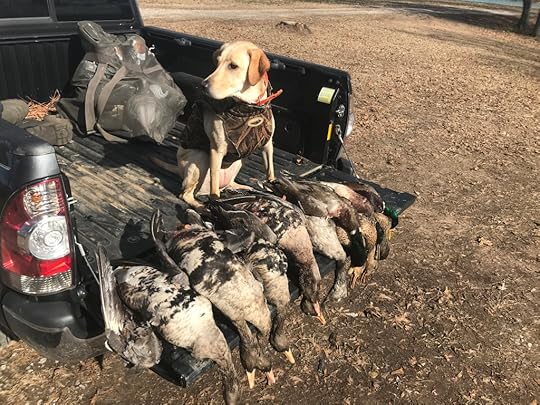 Penny and a good day on the hunt
Penny and a good day on the hunt“I think people who see her lounging around our house and yard in a pink collar,” Jared tells me, “would be surprised to know that she relishes chasing down geese at a hundred yards. I do look at [her] like two different dogs, a spoiled house pet, and an attentive and driven field dog.”
Come to think of it, Penny is a little bit like me. I am attentive when on the wagon—perhaps because people are waving loaded shotguns in my direction—and I also enjoy stretching out on the couch after the hunt like a “spoiled house pet”. But I wonder if there is a trade-off to having a hunting dog live in the house. Next week, we’ll take a look.



